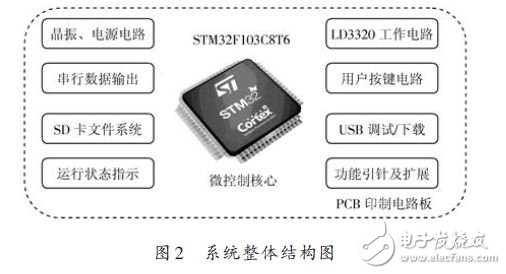Abstract: This paper introduces a design scheme for a non-personal speech recognition system using an ARM processor as the control core. The system in the scheme utilizes IC Route's non-specific speech recognition chip LD3320 and ARM Cortex M3 core ST company's 32-bit high-performance microcontroller STM32F103C8T6 to form the functional main body, realize the SD card file system in the system, without changing the premise of the MCU source program. Under the same, the content of the SD card can be changed to achieve dynamic editing of the identification list keyword. After a lot of practice, the scheme is suitable for the application of the embedded component development, which needs to flexibly change the identification content and the return parameter, and the design has high cost performance, simple interaction, and recognition rate. High and extensible features make it easy to use in embedded applications.
0 Preface
Voice interaction is the most convenient means and the most important media for human communication and exchange of information. For a long time, people hope to find a new way to solve the interaction between humans and machines. I hope that machines can "listen" to understand human speech. Information interacts, recognizes its meaning and responds, and thus acts accordingly. This way of interaction is more acceptable to the user, replacing the traditional interaction methods such as keyboards, buttons, switches, etc., based on non-specific voice recognition technology. It has become an important development direction and research hotspot of the new way of human-computer interaction.
The recognition of speech signals involves many subject knowledge systems, and has close relations with computers, linguistics, communication, mathematical statistics, signal processing and artificial intelligence. Because speech signals have a large amount of information, uncertainty, dynamics and continuity. Sexual characteristics, the amount of data processed in the preprocessing of signal signal, feature extraction and other stages is very large, and the processing algorithms and hardware processing capabilities of software have high requirements. Traditionally, high processing performance such as PC or industrial computer is used. The platform realizes voice signal recognition, but the hardware and software development cost is undoubtedly an important factor hindering the popularization. The system adopts ARM Cortex M3 core ST company's 32-bit high-performance single-chip STM32F103C8T6 combined with LD3320 voice recognition chip, which realizes non-specific by constructing SD card file system. The human voice recognition keyword dynamic editing function is suitable for embedded speech recognition occasions. The system circuit is simple, cost-effective, recognition distance and recognition accuracy can meet embedded applications.
1 Principles of non-specific speech recognition technology
The ultimate goal of non-specific speech recognition technology research is to enable computers and other devices to "understand" human speech and extract the specific information contained in speech, making it the most convenient means for human-computer communication and interaction. Since the speech signal itself has uncertainty, dynamics and continuity, it is very difficult to accurately quantify and process the signal. Each person's speech needs to establish different speech samples and also brings bottleneck constraints to the popularity of recognition. . The current speech recognition is to first establish a feature library and then process the signal to be identified and compare it with the feature library to obtain a similar result decision output. In essence, it belongs to the basic theory based on statistical model. It consists of two major stages: language model training and recognition analysis, as shown in Figure 1.

The acoustic training phase is usually completed offline. The linguists perform signal processing and knowledge mining on pre-collected massive speech samples, language databases, and noise data. The speech recognition system and corresponding mathematical algorithm models are needed to establish a speech recognition system. "Acoustic Model" and "Language Model".
The identification analysis phase is usually done online, automatically identifying the user's real-time speech. The identification process can usually be divided into two modules: “front end†and “back endâ€: the main function of “front end†module is to perform endpoint detection, noise reduction, feature extraction, etc.; the role of “backend†module is to use training. The "acoustic model" and the "language model" perform statistical pattern recognition on the feature vector of the user's speech, and obtain the text information contained therein. In addition, the back-end module also has an "adaptive" feedback module, which can self-speak the user's voice. Learning, thus making the necessary "correction" for the "acoustic model" and "speech model" to further improve the accuracy of recognition.
2 overall structure of the system design
The system uses STM32F103C8T6 microcontroller as the control core, and is equipped with the minimum core circuit of the microcontroller, LD3320 voice recognition circuit, SD card circuit, power supply circuit, user key input circuit, serial data output circuit and status indication circuit. The system is small in size and can be integrated into the user circuit or board as an embedded component unit. After power-on, the STM32F108C8T6 internal program performs program initialization, SD card file system initialization, LD3320 initialization, and then waits to recognize the audio reception. After the recognition is completed, the response information is output. Or decode the audio, the overall structure of the system is shown in Figure 2, and finally realize all the functions of the building block functional components.

Portable power supply humanized output port design: AC dual output port 220V output, to solve multi-channel power demand; DC 24V, 12V cigarette lighter, dual 5V USB output, more widely used. Can meet the needs of most electrical appliances, such as energy storage system for LED Light,energy storage system for outdoor, energy storage system for medical equipment,mobile phones, telephones, digital cameras, mobile hard drives, digital cameras, tablets, laptops, car starters, pumps, postal and telecommunications, environmental instruments Etc; can also be used in the following areas such as: finance, first aid, excavation, exploration, military, science, media, tourism, disaster relief, medical assistance, environmental protection and areas with widespread power shortages.
Outdoor Small Energy Storage System
Solar Storage Battery,Small Solar System,Energy Storage System For Computer,Energy Storage System For Power Tools,Portable Small Electric Station,Multifunctional Lithium Generator
Shenzhen Enershare Technology Co.,Ltd , https://www.enersharepower.com
